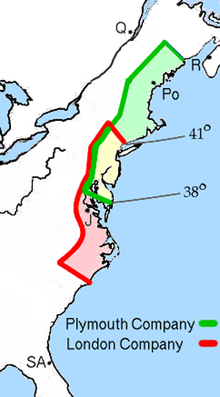
The First Charter of Virginia, also known as the Charter of 1606, is a document from King James I of England to the Virginia Company assigning land rights to colonists for the creation of a settlement which could be used as a base to export commodities to Great Britain and create a buffer preventing total Spanish control of the North and South American coasts.[1] The land is described as coastal Virginia and the islands near to the coast, and stretches from present-day South Carolina to present-day Maine. The patch of land itself would remain the property of the King, with the London Company and the Plymouth Company (the two divisions of the Virginia Company) as the King's tenants, and the settlers as subtenants. The colony's government at first consisted of a council residing in London. The document designated the London Company as responsible for financing the project, which included recruiting settlers and also provided for their transport and supplies.
- ^ King James I (1606), The First Charter of Virginia, retrieved 2009-10-28